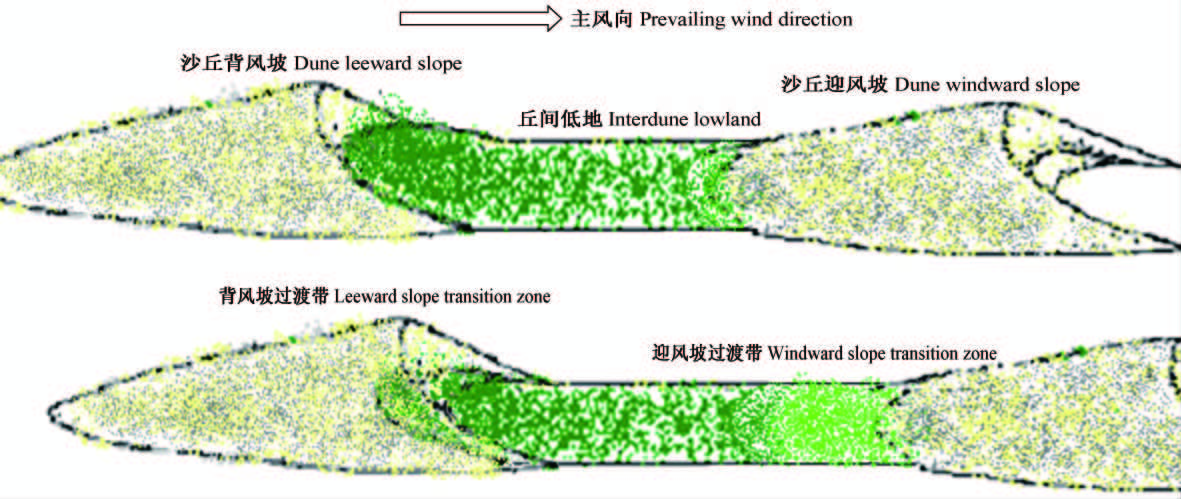文章信息
- 闫守刚, 沈自彬, 李晓东, 许清涛
- Yan Shougang, Shen Zibin, Li Xiaodong, Xu Qingtao
- 流动沙丘与丘间低地过渡带的时空格局对植被恢复的影响
- Effects of Spatial and Temporal Pattern of Transition Zones between Active Dunes and Interdune Lowlands on Vegetation Restorations
- 林业科学, 2015, 51(4): 103-109
- Scientia Silvae Sinicae, 2015, 51(4): 103-109.
- DOI: 10.11707/j.1001-7488.20150413
-
文章历史
- 收稿日期:2013-12-19
- 修回日期:2015-01-10
-
作者相关文章
2. 山东省泗水县环境保护局 泗水 273200
2. Environmental Protection Agency of Sishui County of Shandong Province Sishui 273200
沙区是特定的地质和气候条件以及人为干扰的产物,以沙丘和丘间低地交错分布为主要景观标志(朱震达等,1998;Yan et al.,2005; Yan et al.,2010)。风沙活动是沙丘系统的主要特征,主要包括沙埋(s and burial)和风蚀(aeolian erosion)(蒋德明等,2003)。在风力作用下,流动沙丘背风坡每年以一定的速度前移(蒋德明等,2003),埋压邻近沙丘背风坡的丘间低地植被,形成流动沙丘背风坡-丘间低地过渡带;流动沙丘迎风坡的风蚀导致地下水位升高、土壤含水量增加,沙丘先锋植物入侵,丘间低地植被前移侵占裸沙带(曹成有等,2000; Yan et al.,2007),形成流动沙丘迎风坡-丘间低地过渡带。
流动沙丘-丘间低地过渡带,时空变异大,生态过程复杂(曹成有等,2000; Yan et al.,2007; 闫守刚等,2014),能指示或调节植被-沙丘相对关系。在流动沙丘区,植被自然恢复不仅受沙丘先锋植物繁衍、丘间低地植物种群扩展制约,还受沙丘和丘间低地之间过渡带的植被过程制约(闫守刚等,2014)。沙丘迁移造成的沙丘先锋植物与丘间低地植物间的此消彼长能调整整个流动沙丘区的植被面积和格局:如果流动沙丘前移埋压丘间低地植被的速度超过丘间低地前移侵占裸沙的速度,则流动沙丘区植被覆盖面积将呈衰减趋势,反之呈增加的趋势(图 1)。
 |
图 1 流动沙丘前移埋压背风坡过渡带植被与丘间低地前移侵占迎风坡过渡带裸沙的权衡关系 Fig. 1 The trade-offs between leeward slope ecotones and windward slope ecotones |
目前,人们对流动沙丘和丘间低地之间过渡带的生态过程还知之甚少,对诸如本过渡带的时空格局及其对流动沙丘-植被面积关系的调控作用等问题尚不清楚。
本研究以科尔沁沙地流动沙丘-丘间低地过渡带为研究对象,通过野外监测流动沙丘与丘间低地过渡带的时空动态,研究流动沙丘与丘间低地过渡带的时空格局对流动沙丘-丘间低地单元植被面积的影响,探讨沙埋和风蚀如何影响流动沙丘与丘间低地过渡带时空格局,过渡带变化如何影响流动沙丘-丘间低地单元的植被面积。
1 研究方法研究区位于科尔沁沙地西部乌兰敖都地区,该区是科尔沁沙地的典型地段,流动沙丘和丘间低地相间分布。
1.1 野外监测与调查1)选择二片相邻沙丘区,根据群落结构或面积、形状,在沙丘区选择7处典型丘间低地(为了消除沙丘高度的影响,背风坡沙丘高度均在20~25 m之间),调查地貌、土壤和植被状况,用GPS测量丘间低地面积和周围沙丘高度,确定沙丘与丘间低地过渡带(包括迎风坡、背风坡与丘间低地过渡带)可能出现的位置。根据刘媖心(1985;1987;1992)文献确定丘间低地的植物种类。
2)2008年11月初,在7处流动沙丘背风坡与丘间低地的连接处,每处按相同间隔距离设立4条样带,在样带上每隔1 m设立一根高150 cm的测钎,共设置7根,记录其初始位置。2009年和2010年4—9月,每月测量1次沙埋距离,确定沙丘移动距离和形成的背风坡过渡带的季节、位置变化。
3)2008年11月初,在7处流动沙丘迎风坡与丘间低地连接处,每一处都按相同间隔距离设立4条样带,在样带上每隔1 m设立一根高100 cm的测钎,共设置7根,记录其初始位置。2009年和2010年的4—9月,每月量测1次风蚀深度和沙丘移动距离,确定形成的迎风坡过渡带的季节、位置变化。
4)2008年11月初,在新形成沙丘背风坡的所有测钎附近设置1 m×1 m的样方,调查样方内植物的丰富度、多度和高度。
5)2009年和2010年9月底,在每一处形成的沙丘迎风坡过渡带的所有测钎附近设置1 m×1 m的样方,调查样方内植物的丰富度、多度和高度。
1.2 数据分析2009年和2010年9月底,根据流动沙丘背风坡沙埋距离确定流动沙丘背风坡-丘间低地过渡带的宽度,取2年背风坡沙埋距离的平均值作为背风坡过渡带的宽度。
2009年和2010年4月和9月底,根据迎风坡裸沙带的植被建植状况,测量并确定流动沙丘迎风坡-丘间低地过渡带的宽度,取2010年4月和9月迎风坡裸沙带的植被建植宽度的平均值作为迎风坡过渡带的宽度。
利用SPSS11.5和Excel 进行数据处理。利用双变量相关分析,分析流动沙丘-丘间低地过渡带宽度与丘间低地面积、植被扩展宽度及其垂直风向宽度的相关性,P < 0.05为相关性显著。
2 结果与分析 2.1 过渡带的时空格局二片相邻沙丘区的7处丘间低地植被与地形和地貌状况如表 1所示。根据地形和地貌,确定沙丘迎风坡与背风坡与丘间低地之间过渡带的位置。
|
|
沙埋导致流动沙丘背风坡与丘间低地过渡带形成,背风坡过渡带在每年5月底风季结束时基本形成,在6月有些较小的发展,在此后的7—9月基本保持不变(图 2a)。2009和2010年,流动沙丘背风坡与丘间低地过渡带沙埋宽度分别为0.83~5.45 m和1.25~5.35 m。
 |
图 2 流动沙丘背风坡与丘间低地过渡带沙埋(a)、迎风坡与丘间低地过渡带风蚀(b)的时间动态 Fig. 2 Burial (a) or erosion(b) temporal patterns of transition zones between leeward or windward slopes of active sand dunes and interdune lowlands |
风蚀导致流动沙丘迎风坡与丘间低地过渡带形成,迎风坡过渡带在每年4月底基本形成,在5—6月有微弱波动,在此后的7—9月基本保持不变(图 2b)。2009和2010年,流动沙丘迎风坡与丘间低地过渡带风蚀深度分别为2.9~25.8 cm和4.0~22.1 cm。
植被侵入流动沙丘迎风坡裸沙带并形成建植种群标志着迎风坡过渡带的最终形成,所以可根据生长季末植被建植状况确定迎风坡过渡带的宽度。2009年和2010年9月底,沙丘迎风坡过渡带的宽度分别为1.5~8.0 m和2.0~9.5 m(表 2)。由于强烈的风沙活动,迎风坡过渡带在年际间出现波动,2010年4月底生长季开始前,迎风坡过渡带的宽度(0~1.5 m)远远小于2009年9月底生长季结束时的宽度(过渡带2除外)(表 2)。
|
|
背风坡过渡带沙埋宽度(即背风坡过渡带宽度)2年监测的平均值为1.04~5.49 m,迎风坡植被建植宽度(即迎风坡过渡带宽度)2年调查的平均值为1.00~7.92 m(表 3)。
|
|
总体来看,研究区内流动沙丘前移埋压丘间低地植被的速度超过了丘间低地前移侵占裸沙带的速度,丘间低地植被扩展宽度的代数和是-3.5 m,但是植被扩展面积代数和是238 m2。这是因为植被扩展面积除了与植被扩展宽度有关外,还与丘间低地主风向宽度有关。过渡带7的面积大(5.3 hm2),主风向宽度也大(240 m),导致其丘间低地植被扩展面积大(528 m2),因此,虽然7处丘间低地植被扩展宽度为负值,但是植被扩展面积代数和却为正值。这也表明大面积丘间低地对过渡带植被恢复乃至沙丘区植被恢复的重要性。
2.3 丘间低地面积、宽度与过渡带宽度的关系流动沙丘背风坡-丘间低地过渡带宽度与丘间低地面积及其垂直风向宽度都呈显著负相关(P < 0.05),与迎风坡过渡带宽度和丘间低地植被扩展宽度的相关性不显著(P>0.05);流动沙丘迎风坡-丘间低地过渡带宽度与丘间低地面积及其垂直风向宽度的相关性不显著(P>0.05),但是与丘间低地植被扩展宽度呈显著正相关(P < 0.05)(表 4)。
|
|
流动沙丘背风坡在风力作用下,沙子埋压丘间低地植被,导致部分沼泽-草甸植物退出丘间低地,在每年5月底风季结束时形成背风坡过渡带(图 2a)。
流动沙丘在冬春季西北向主风和夏季的西南向主风的共同吹蚀下,在沙丘迎风坡底部前沿,每年4月底形成一条沿沙丘下部边缘走向的裸沙带,这个宽度也就是该地区流动沙丘每年前移的距离(曹成有等,2000)。5月初,沙生植物沙蓬、乌丹蒿、芦苇和黄柳等幼苗侵入裸沙带,在生长季末形成建植种群,最终形成迎风坡过渡带(图 2b)。
迎风坡过渡带的宽度为3~5 m,背风坡过渡带的宽度为4~6 m(表 3),因此,流动沙丘与丘间低地过渡带属于小尺度过渡带。风蚀和沙埋导致流动沙丘向前移动,每年都会产生新的过渡带,其生命周期是1年或数年,因此,其动态变化过程属于快速变化类型,在空间上属于锐变类型。
根据常学礼等(1999)和邬建国(1991;2007)对尺度效应和等级理论的解释:空间尺度越小,等级越低,其组成要素的变化速率越快,流动沙丘-丘间低地过渡带作为小尺度过渡带,处于最低等级,具有尺度效应,符合等级规律。
3.2 丘间低地面积对过渡带空间格局的影响丘间低地的植被恢复在沙丘区的植被恢复中也起重要作用,因为沙丘区的植被恢复多数情况下开始于丘间低地的植被恢复(闫守刚等,2012;2014)。流动沙丘的前移对丘间低地植被恢复过程的影响主要有2个方面:背风坡过渡带沙子掩埋丘间低地的植被,迎风坡过渡带风蚀导致新生植被的建植和扩展。二者的权衡调节丘间低地植被覆盖面积,进而调节整个流动沙丘区植被覆盖面积。因此,降低沙丘背风坡沙埋速度和增加新生植被入侵迎风坡过渡带裸沙带的速度在沙丘植被自然恢复过程中至关重要。
面积大的丘间低地(如过渡带7),垂直风向宽度大,且植被密度大、植株高,容易形成风障降低风速,致使背风坡沙埋速度小,而且迎风坡植物入侵速度大,导致丘间低地植被宽度和面积增加(表 3,4);多年生植物如芦苇利用营养繁殖快速入侵迎风坡过渡带(如过渡带2),导致丘间低地植被宽度和面积增加(表 3)。过渡带6和3的多年生植物芦苇和黄柳有性繁殖速度虽然很大,但对土壤水分要求较高,2年监测期内只有1年出现有性繁殖苗,所以其在过渡带植被建植宽度低于背风坡沙埋宽度,导致丘间低地植被面积减少。因此,在沙丘区恢复实践过程中,一方面应该重点保护大面积丘间低地;另一方面,可以采用在丘间低地迎风坡前缘挖沟种植芦苇的方式,利用芦苇营养繁殖快速入侵的特点,增加丘间低地植被面积,达到沙丘植被恢复的目的。
4 结论1)流动沙丘背风坡-丘间低地过渡带的宽度与丘间低地面积及其垂直风向宽度都呈显著负相关;流动沙丘迎风坡-丘间低地过渡带的宽度与丘间低地面积及其垂直风向宽度的相关性不显著,但与丘间低地植被扩展宽度呈显著正相关。
2)流动沙丘区植被覆盖面积呈增加趋势。
3)大面积(>5 hm2)的丘间低地对于流动沙丘区的植被恢复具有重要作用。
| [1] |
曹成有, 寇振武, 蒋德明, 等. 2000. 科尔沁沙地丘间地植被演变的研究. 植物生态学报, 24(3): 262-267. (Cao C Y, Kou Z W, Jiang D M, et al. 2000. Interdune succession in the Kerqin sandy region. Acta Phytoecologica Sinica, 24(3): 262-267[in Chinese]).(  3) 3)
|
| [2] |
常学礼, 赵爱芬, 李胜功. 1999. 生态脆弱带的尺度与等级特征. 中国沙漠, 19(2): 114-119. (Chang X L, Zhao A F, Li S G. 1999. Spatial-temporal scale and hierarchy of vulnerable ecotone. Journal of Desert Research, 19: 114-119[in Chinese]).(  1) 1)
|
| [3] |
蒋德明, 刘志民, 曹成有,等. 2003. 科尔沁沙地荒漠化过程与生态恢复. 北京: 中国环境科学出版社. (Jiang D M, Liu Z M, Cao C Y, et al. 2003. The desertification process and ecological restoration in Horqin Sandy Land. Beijing: China Environmental Science Press.[in Chinese])(  1) 1)
|
| [4] |
刘媖心. 1985. 中国沙漠植物志.第1卷. 北京: 科学出版社. (Liu Y X. 1985. Flora in Desertis Reipublicae Populorum Sinarum. Tomus 1. Beijing: China Science Press. [in Chinese])(  1) 1)
|
| [5] |
刘媖心. 1987. 中国沙漠植物志. 第2卷. 北京: 科学出版社. (Liu Y X. 1987. Flora in Desertis Reipublicae Populorum Sinarum. Tomus 2. Beijing: China Science Press. [in Chinese])(  1) 1)
|
| [6] |
刘媖心. 1992. 中国沙漠植物志. 第3卷. 北京: 科学出版社. (Liu Y X. 1992. Flora in Desertis Reipublicae Populorum Sinarum. Tomus 3. Beijing: China Science Press. [in Chinese])(  1) 1)
|
| [7] |
闫守刚,许清涛. 2012. 流动沙丘与丘间低地过渡带上芦苇幼苗的出土和定居. 林业科学, 48 (9): 50-55. (Yan S G, Xu Q T. 2012. Seedling emergence and establishment of Phragmites communis in transition zones between active dunes and interdune lowlands of active dune fields. Scientia Silvae Sinicae, 48(9), 50-55 [in Chinese]).(  1) 1)
|
| [8] |
闫守刚,许清涛, 曹凤伟. 2014. 半干旱沙区流动沙丘与丘间低地过渡带的植被空间变化过程.东北林业大学学报, 42(10): 60-64. (Yan S G, Xu Q T, Cao F W. 2014. Vegetation processes of transition zones between active dunes and interdune lowlands in semi-arid dune areas. Journal of Northeast Forestry University, 42(10): 60-64[in Chinese]).(  3) 3)
|
| [9] |
邬建国. 1991. 耗散结构,等级系统理论与生态系统. 应用生态学报, 2(2): 181-186. (Wu J G. 1991. Dissipative structure, hierarchy theory and ecosystem. Chinese Journal of Applied Ecology, 2(2): 181-186[in Chinese]).(  1) 1)
|
| [10] |
邬建国. 2007. 景观生态学——格局、过程、尺度与等级.2版. 北京: 高等教育出版社. (Wu J G. 2007. Landscape Ecology—Pattern, Process, Scale and Hierarchy. 2nd ed. Beijing: Higher Education Press.[in Chinese])(  1) 1)
|
| [11] |
朱震达, 赵兴梁, 凌裕泉,等. 1998. 治沙工程学. 中国环境科学出版社. (Zhu Z D, Zhao X L, Ling Y Q, et al.1998. Sand engineering. Beijing: China Environmental Science Press.[in Chinese])(  1) 1)
|
| [12] |
Yan Q L, Liu Z M, Zhu J J, et al. 2005. Structure, pattern and mechanisms of formation of seed banks in sand dune systems in northeastern Inner Mongolia, China. Plant and Soil, 277: 175-184.( 1) 1)
|
| [13] |
Yan Q L, Liu Z M, Ma J L, et al. 2007. The role of reproductive phenology, seedling emergence and establishment of perennial Salix gordejevii in active sand dune fields. Annals of Botany, 99: 19-28.( 2) 2)
|
| [14] |
Yan S G, Liu Z M. 2010. Effects of dune stabilization on the plant diversity of interdune wetlands in northeastern Inner Mongolia, China. Land Degradation & Development,21: 40-47.( 1) 1)
|
 2015, Vol. 51
2015, Vol. 51

